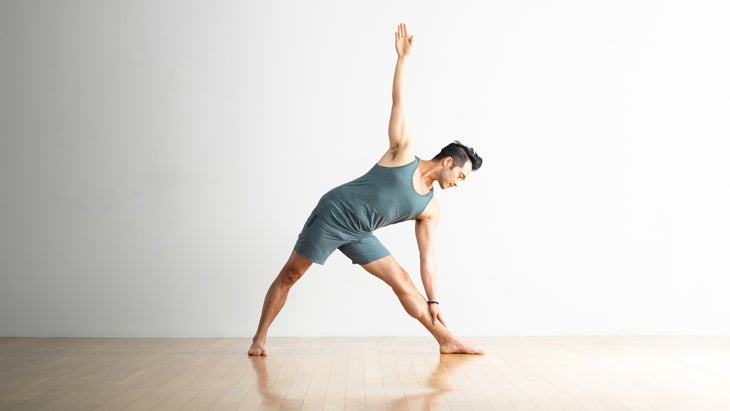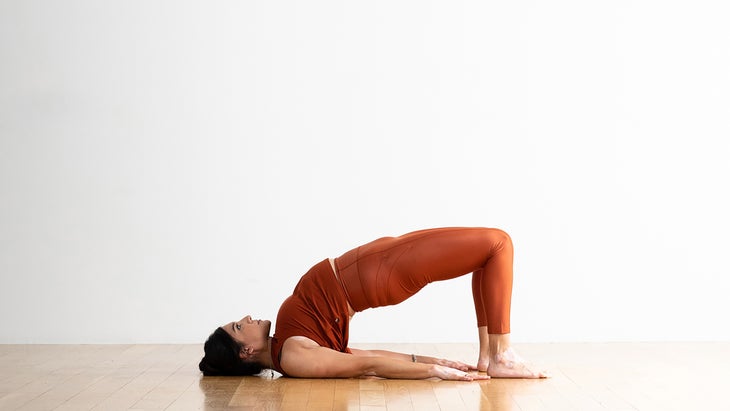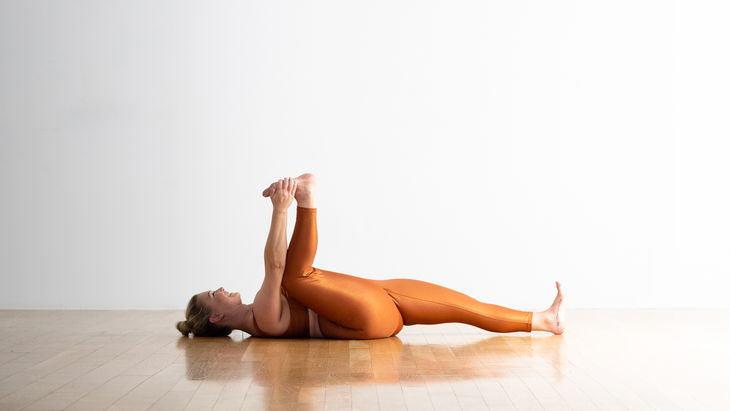“], “filter”: { “nextExceptions”: “img, blockquote, div”, “nextContainsExceptions”: “img, blockquote, a.btn, a.o-button”} }”>
Even if it’s from that delicious slice of pizza, late-night Netflix noshing, or the irresistibly rich chocolate mousse, bloating and indigestion never feel good. And digestive issues can rise to the level of chronic medical conditions such as inflammatory bowel syndrome and Crohn’s disease, that can be severe and debilitating.
“I was diagnosed with ulcerative colitis in my early 20s,” says Govind Das, Kirtan musician and owner of Bhakti Yoga Shala in Santa Monica. “After months of crippling sickness and spending eight days in the hospital receiving blood transfusions, I was told I would be on medication to control my inflammatory bowel disease for the rest of my life.”
In the face of that diagnosis, he took a friend’s suggestion and attended his first yoga class. Over time the practice helped. He credits Bhakti Yoga, asana, and Ayurveda for aiding his recovery.
Even if we’re not facing such a severe diagnosis, we could all benefit from better digestion. That’s where yoga comes in.
Connecting Your Gut and Your Brain
While medical experts stop short of suggesting that yoga “wrings out” the digestive organs—something we often hear in yoga classes—there is some evidence that yoga poses tone the vagus nerve (VN) which communicates information between the gut and the brain. Low vagal tone has been connected with GI disorders.
“Stress inhibits the VN and has deleterious effects on the gastrointestinal tract,” according to research published in Frontiers in Neuroscience. Researchers think stimulating the anti-inflammatory properties of the vagus nerve could help restore balance along the gut/brain axis. This could be beneficial to people diagnosed with digestive conditions.
Try this sequence—which combines stretches and twists that target abdominal organs—to relieve a wide range of digestive discomforts (think: gas, bloating, constipation). Combine the movements with diaphragmatic breathing which also provides a gentle massaging action to the internal organs that might ease GI symptoms. (But, of course, if your discomfort becomes chronic or gets worse, see your health care provider.)
Marjaryasana-Bitilasana (Cat-Cow)
Bring your hands beneath your shoulders and knees beneath your hips. Inhale as you drop your belly button toward the earth and lift your heart and hips to the sky into Bitilasana (Cow Pose). Spread your shoulders apart and away from your ears. On an exhalation, round your upper back toward the sky, dropping your gaze to your navel and pressing your hands and feet into the earth in Marjaryasana (Cat Pose). Continue for 10 rounds.
Breathing deeply in these poses will massage your organs as you alternately compress and lengthen the intestines, bringing fresh blood to the epithelial cells, which are responsible for healthy gut function.
Adho Mukha Svanasana (Downward-Facing Dog Pose)

Come into Plank Pose to set up your hands and feet. Place your hands shoulder-distance apart and feet outer-hip-distance apart. Then, using your core, press your hips up and back. To broaden your back, bend your knees slightly to lengthen your spine and spread your shoulders wide.
Use Down Dog to take deep breaths into your belly, pulling the navel up and in toward the back of your heart each time you exhale. Breathe for 5 to 10 rounds.
Utthita Trikonasana (Extended Triangle Pose)

From Down Dog, step your left foot forward into a High Lunge and then straighten your left leg. Walk your right foot forward 6 inches and angle it so that your toes face the front-right corner of the mat. Keep your heel flat on the ground. Rotate your torso, opening your body to the right. Reach your right hand to the sky with your palm facing outward, and rest your left hand lightly on your left shin, on a block or on the floor. Stretch the crown of your head forward as you reach your tailbone toward your right heel. Breathe in Utthita Trikonasana for 5-10 breaths and then move to Parivrtta Trikonasana (below) before switching sides.
Parivrtta Trikonasana (Revolved Triangle Pose)

Release your right hand to the earth and level your hips—keeping the right hip in line with your left. Keep your legs stable and strong by engaging your quads and keeping a micro-bend in both knees. Twist to the left and reach your left arm up toward the sky with your palm facing away from your body. Breathe in this pose for 5 breaths, then repeat Utthita Trikonasana and Parivrtta Trikonasana on the other side.
By compressing and releasing the colon in this pose, you will stimulate the organs. For those with Inflammatory Bowel Disease, Jean Koerner, yoga teacher and former co-owner of Be Yoga Studios, advises proceeding with caution in this pose, as it may cause unwanted pressure on the organs.
Uttana Shishosana (Extended Puppy Pose)

Come onto your hands and knees in Tabletop. Then, keeping your hips where they are, walk your hands forward and lower your body until you are able to release your head onto the floor or a block. Open your shoulders by moving your shoulder blades away from each other. Allow gravity to open your heart.
Uttana Shishosana pose is especially useful for stretching the belly to relieve cramps after a large meal.
Setu Bandha Sarvangasana (Bridge Pose)

Bridge Pose is a great backbend for compressing the digestive organs, while simultaneously delivering fresh blood to the heart and relieving any fatigue that may be caused by poor digestion.
To enter this pose, lie on your mat and place your feet flat on the floor as close to your sitting bones as possible. Exhale and press your inner feet and arms into the floor as you lift your hips toward the sky, stretching your knees forward. Place a block beneath your sacrum for a more passive backbend. Take 10 deep breaths here, then slowly roll your spine down to release.
Ardha Pawamuktasana (Half Gas-Release Pose)

Look no further than the name of this posture to discover its healing benefit: Pawan = air or gas. Mukta = release. This pose compresses the ascending colon on the right side and descending colon on the left, stimulating the nerves to aid elimination. Hug your right knee in toward the right side of your ribcage. Keep pressing your straight left leg into the earth. You may clasp your hands around your right shin to pull it closer you. Hold for 1 to 2 minutes. Repeat on the other side.
Supta Matsyendrasana (Supine Spinal Twist)

From Bridge Pose, bring your feet together and release your knees to the left, stretching your right arm straight out to the right for a Supine Twist. For a deeper stretch, rest your left hand gently on your right knee. You may also straighten your right leg and extend it out to the left. Reach your left hand toward your right toes or outer right foot. Relish in this deep, releasing twist as long as feels good. Return to center and repeat on the other side.
Savasana (Corpse Pose)

From Supine Twist, bring both knees into your chest to neutralize your spine. This front-body compression will aid elimination by stimulating the transverse colon. Then allow your legs to straighten gently to the ground and rest the palms face up next to your hipbones. You may choose to roll a blanket or towel and place it under your knees. Let your breathing become natural as you relax all your muscles.
Jean Koerner believes quieting the mind in poses like Savasana is the most essential part of the practice because it calms the nervous system. “Relaxation helps to counterbalance the effects of stress, which leads to these conditions,” she says. Addressing the reason for the discomfort can help alleviate the symptoms.
This article has been updated. Originally published on July 25, 2014.
Casey Coviello, RYT-200, a former Yoga Journal intern, has extensive experience providing health-related products and services.

